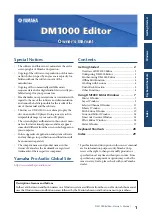
Chapter 1
Introduction to the LabVIEW Order Analysis Toolset
LabVIEW Order Analysis Toolset User Manual
1-2
ni.com
application is built with components found in the LabVIEW Order
Analysis Toolset.
The order analysis application provides an example of how the LabVIEW
Order Analysis Toolset can help you successfully complete analysis
projects. The simple processes included in the order analysis application
enable you to perform data acquisition, tachometer analysis, tachless speed
profile generation, order analysis, and online monitoring of noise or
vibration signals generated by rotating machinery. You also can use the
order analysis application as a simple order analysis VI in projects or as
a tool to learn the basics of building and using LabVIEW Order Analysis
Toolset VIs.
Important Considerations for the Analysis of Rotating
Machinery
Order analysis is a powerful tool for analyzing rotating machinery when the
rotational speed might change over time. However, to successfully use the
LabVIEW Order Analysis Toolset, you must observe the following
condition and restriction:
•
Provide a signal directly related to the position of the shaft, such as a
pulse train from a tachometer or key phasor. Although the LabVIEW
Order Analysis Toolset can measure the magnitude of the order
components without a tachometer signal, the measurement of the
phase of the order components requires a tachometer signal.
•
Do not use the LabVIEW Order Analysis Toolset for analysis of
frequencies that are not excited by a fundamental frequency, such as
the modes encountered in modal analysis. Although you can observe
the different modes in the frequency domain, no simple relationship
exists among those different modes. Usually, the frequencies of
different modes are not simply a multiple of a fundamental frequency
over time.










































